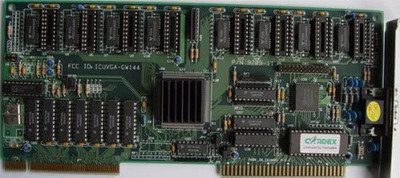First post, by douglar
- Rank
- Oldbie
I was looking to expand this section of the wiki: http://www.vogonswiki.com/index.php/IDE_controller
I started with this great post: Re: 3 (+3 more) retro battle stations
Then I looked through pictures on ebay.
Looking for anyone who can help fill out this list
Brand |Chip |1stFab|Drv | Mode|Board Example |NotesADD2 |DW729 |9349|DOS | |VLSIO2C3 VL AD|https://www.lawinsider.com/contracts/72c3xLf5kBAALI |M5213 |9423| | |Palm VL-BUS Rev|Used on a Cirrus video card similarly to the Mervin CT9000Appian |ADI/2 |9321|DOS | |CLPD7220 |formerly ZyMOS Corporation. Also sold as Adaptec AIC-25VL01Q & Cirrus Logic CL-PD7220Atronics |IDE-2015PL |9436|DOS |PIO-4|IDE-2015PL |Also sold as DTC 803Atronics |IDEC-2020L |9420|BIOS| |CPDC200BRC |Looks like a SCSI controller to the PCCMD |PCI0640B |9448|DOS |PIO-4| |California Micro Devices, Later Silicon ImageCompasLab |CL3202 |9335| | | |Also sold as GM82C712DTC |DTC 805 |9410|DOS |PIO-3| |PIO 2 MAX speedsGoldStar |GM82C711 |9303|DOS |PIO-4| |This isn't a PC Chips 82C711GoldStar |GM82C712 |9517| |PIO-3|CLT14B31293 |Also sold as CompassLab CL3202Holtek |HT6560A |9445| |PIO-2| |Does not work with the HT6560B driverHoltek |HT6560B |9509|DOS |PIO-4|VIO3B-V1.1 |Lion |Lion 3+ |9519|DOS |PIO-3|AYCOMP-9401 |https://www.vogons.org/viewtopic.php?p=293802Mervin |CT9000 | | | | |Used on a Cirrus video cards similarly to the ALI M5213OPTI |82C611A |9436|DOS |PIO-3|VSI-PV1 VLB |Sometimes labled Opti VIC (VIC = Vesa Ide Controller)PiC |12885A-125 |9345| | |VLMIOv1.6 |Sometimes labled VIDE-1Promise |PDC-20130 | | | |DC4030VL-2 |Caching ControllerPromise |PDC-20230b |9320|DOS | |DC-2000VL-2A |Promise |PDC-20230c |9340|DOS |PIO-3|DC-4000 |XUB supportPromise |PDC-20330A |9415| | | |Caching ControllerPromise |PDC-20430 |9420|DOS | |DC440 |Caching ControllerPromise |PDC-20630 |9427|DOS |WDMA2|EIDE2300Plus |XUB supportQDI |Vision 5500 | | | |QD5500A |Seen in Linux notes, never seen the chipQDI |Vision 6500 |9323|DOS |PIO-2|QD6500 |XUB supportQDI |Vision 6580 |9451|DOS |PIO-4|QD6580 |XUB supportSIS |83C601 |9511|DOS | |TyanS1346 |Newer than the 83C611SIS |83C611 |9342|DOS |PIO-3|TyanS1345 |Older than the 83C601Tans |TS8310 |9425| | |TS-8310VLT VC.1|Tans TS8310a appeared in 1995, functinally the sameTekram |ST100AII | | | |Tekram DC-600T |Tekram |ST300ALI | |DOS | |Tekram DC-680T |Raid SupportUMC |UM82C871F |9330|DOS | |TK82C863587 |UMC |UM85C418F |9349|DOS |PIO-3|Vertext VL-1AV |Combo IDE & VGA controllerUMC |UM8672 | |DOS | |TK HBQUMC8287D1|UMC |UM8672F |9437|DOS |PIO-3|SST-2946-X |PIO-4 with Modded DriverVIA |VT83C461 |9508|DOS | |KG9AV150 |Has a BIOS / AV140 / AV150 / AV300Winbond |W83759AF |9505|DOS |PIO-4|WBIDE-D |winbond_portWinbond |W83759F |9403|DOS | |UN1082 |
Edits:
Removed Acer M5105 because it is an ISA chip, not a VLB IDE controller
Consolidated GoldStar GM82C712 / CompassLab CL3202 under Chips 82C712
Added some Max ATA info
Added Lion 3+
Removed UM82C863F because it wasn't a VLB IDE chip but an ISA IO controller
Added PIO info, HT6560A and two opti chipsets from https://github.com/torvalds/linux/blob/789b4a … a_legacy.c#L862
Collected a bunch of drivers
VIC is a Via Chip
Added Several new chips
Added Mervin, Removed the couple that were PCI & ISA
Added UM85C418F
Added SIS601, which is a newer chip than the SIS611
Added TANS8310a, which was fabbed 5 weeks later than the TANS8310 (9450 vs 9503)
2024-04-04 Removed some of the lines that were integrated chipsets, never used in addin boards. Removed some chips that were data collection mistakes
2024-04-05 Removed VT83C561 from the list because it looks like it was PCI, not VLB. Found a reference to a card built around the QD5500a
2024-04-11 Merged Duplicate entries, added first fab
links to other good vlb posts:
Re: Is there a VLB card that supports > Mode 3 or UDMA support?
Please recommend me some high-end VLB IDE controller
Re: 3 (+3 more) retro battle stations
Re: 3 (+3 more) retro battle stations
VLB IDE cache controllers, benchmark
